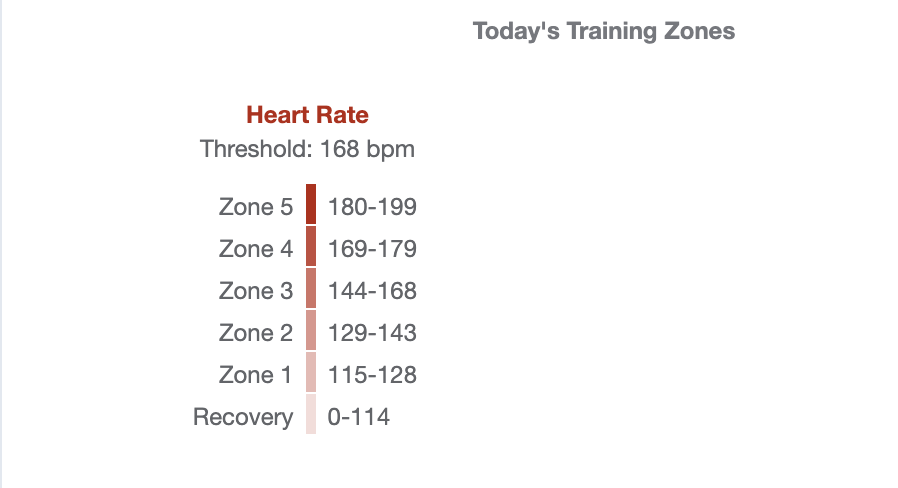Zone 2 Heart Rate Question
|
|
Hey all, I was looking at some training I've done in what I think is zone 2 and wanted to get some sort of confirmation of that because I'm getting mixed signals from Polar Flow and Training Peaks. Training peaks (the pic with the bar chart) has my heart rate for Zone 2: Aerobic from 136-150 bpm and Zone 3: from 151-156 BPM. Now I can still breathe through my nose up to 154 bpm (partially deviated septum) even if its pretty labored. My max heart rate is 199 bpm based on a max heart rate test I did back in high school for rowing so I've been basing everything off of that. Now polar flow gives me a very different number, Zone 2 is from 119-139 bpm and Zone 3 is from 139 to 159 bpm which is obviously very different from training peaks. I had a heart rate drift of 4% when I sat in what I thought was zone 2 between 145 bpm +- 10 over an hour period, I tested this by nose breathing the entire time. This followed the instructions of the aerobic threshold test that I had read on uphill athlete's website. I guess what I mean to ask is, am I going too hard for zone 2 workouts and if so what heart rate should I be shooting at given this difference between the two apps? |
|
|
Here is the polar flow screenshot just in case that helps anyone give advice on the subject. Thank you very much for your guys's help! |
|
|
I base mine on 180 minus my age for the upper end of Z2. If I can still hold a conversation or breathe through my nose I consider it successful. |
|
|
It sounds like you self-administered an aerobic threshold test, and if you think the result is accurate, then you just need to go into "Settings" in your TP account and manually adjust your zones... don't rely on the automatic TP (or Polar) values the algorithm populates for your zones. Use your aerobic threshold to set the top of Z2; bottom of Z2 is AeT - 10%; top of Z1 is Z2 - 1 bpm; bottom of Z1 is AeT - 20%; and recovery zone is everything below hat. (You have to separately do an anaerobic test for your top of Z3 value.) Good info here: https://evokeendurance.com/setting-your-hear-rate-zones/ All that said, setting your zones- and therefore determining intensity ie HR target while out training each and every session- depends on an accurate aerobic threshold test. Here are the best instructions for a solid test, IMO: evokeendurance.com/our-late…. Do it on the treadmill. It took me a few times to yield an accurate result within the acceptable 3.5-5% HR drift. It's worth repeating if you don't nail it the first time, because that threshold is so pivotal to successful training. I was totally humbled with how low my AeT was when I first started doing this, and then equally inspired as I saw myself get fitter following the process as outlined by the experts who wrote the book. |
|
|
It's been a while, but if i remember correctly one issue with all of this is that different sources define the zones differently (ie some will call the light endurance / aerobic range zone 1 and others call it zone 2). |
|
|
John Thomson wrote: Right, thank you for the quick reply! After reading through these links and running the test, I confirmed a heart rate drift of 3.6% with my aerobic threshold being 143 bpm, not doing any sort of consistent cardio for a year might have had a toll on my aerobic fitness so I'm definitely humbled. Until I do my anaerobic test which I now have scheduled I'll be running off the heart rate zones shown in the image below. Thank you very much again for the information and help on this! |
|
|
John Thomson wrote: Yes. this. |
|
|
Worth noting: The Polar HR zones are just 10% blocks based on max heart rate (50-60%, 60-70%, 70-80%, 80-90%, 90-100%). As such they are very likely to be inaccurate for most people if you’re trying to use them for anything beyond extremely basic metrics. They won’t be based on any fitness metrics, nor will they change over time as fitness changes, because they only look at your manually entered max HR. For following TFTNA-style plans, the Polar zones are not really useful. The Training Peaks zones are calculated based on data you input and theoretically will adjust themselves based on workout data, so they can be more accurate IF the baseline data is good. |
|
|
Others have covered the importance of running a drift test, here is a calculator that i found a bit easier to use then training peaks: https://douglas-watson.github.io/aet-calc/index.html
|
|
|
It’s also worth noting that lab testing costs less than many people think. Many universities will do it for $150-200. And sometimes that even includes metabolic efficiency data. |

 Continue with onX Maps
Continue with onX Maps Sign in with Facebook
Sign in with Facebook
























